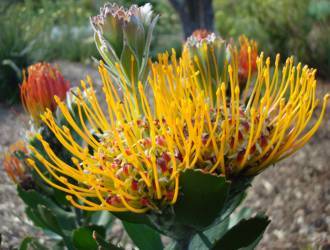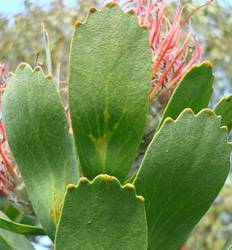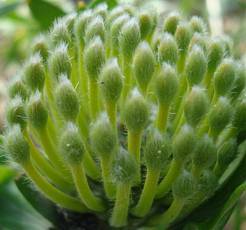Leucospermum praecox
Leucospermum praecox Rourke
Family: Proteaceae
Common names: Mossel Bay pincushion; large tufted pincushion
Introduction
Leucospermum praecox flowers before most other pincushions and creates an eye-catching display from mid-autumn all through winter.

Description
Description
Leucospermum praecox is a rounded, robust shrub up to 2-3 m tall and 4 m wide. It is bushy and has an upright habit. The trunk can reach 80 mm in diameter. Leaves are obovate to wedge-shaped, 35-70 x 15-30 mm and overlap each other. They are soft and hairy when young. The hairs give the young leaves a whitish, light green appearance. After a year, the leaves lose the hairs and become smooth and leathery. Each leaf tip has 5-11 glandular teeth.


Bushes are floriferous and sometimes have 4 flowers on the tips of branches. Flowering occurs between April and September. Flower heads measure 60 mm across and have a spherical shape. Flower buds first open as a tightly curled lemon-yellow-green whorl. As they unfurl the styles become darker yellow and finally orange while the pollen presenter (tip of style) remains yellow. Once the flowers have been pollinated or the flowers begins to age, the styles and pollen presenters darken to red.


Seeds ripen in the flower head for two months. After this, the large nut seeds are released and fall to the ground where they are carried underground by ants.
Conservation Status
Status
Leucospermum praecox is listed as Vulnerable on the current Red Data List.
It occurs over a large area but its habitat is rapidly being diminished due to expanding farming activities.
Distribution and habitat
Distribution description
Leucospermum praecox occurs on the Riversdale Flats between Albertinia and Mossel Bay. It grows in white sandy soil at an altitude of 0-250m.
Derivation of name and historical aspects
History
The name Leucospermum is derived from the Greek leukos, meaning white and sperma, meaning seed. The seeds are actually black but are coated with a white fleshy skin (elaiosome). Praecox means early or premature and alludes to the early flowering.
Ecology
Ecology
Leucospermum seeds are covered by a soft white fleshy skin. When the seeds fall to the ground, ants collect them and take them underground to their nests. They eat the fleshy skin (elaiosome) and the seed is now planted snuggly underground where it is safe from predation and fire. This is known as myrmecochory. Mature plants are killed by fire and rely on the ants to bury their seeds so that they can germinate after fire.
Flowers are pollinated by birds.
The dense, soft, velvety hairs found on the new soft delicate leaves during the first year protect them from drying out in the sun and from being eaten by predators. After the first year, the hairs disappear and the leaves harden, become smooth and develop a waxy coating.
Uses
Use
Leucospermum praecox is a great addition to any fynbos garden and is also suitable as a cutflower.
Growing Leucospermum praecox
Grow
Leucospermum praecox can be propagated from cuttings or seed but cuttings have a much higher success rate than seeds.
Make cuttings from December to March (summer to autumn). The cuttings should be semi-hardwood, 60-100 mm long, and taken from the current season's growth. Dip the cuttings into a rooting hormone solution or hormone powder and plant into a medium of 50% polystyrene and 50% finely milled bark. Place in a growing house with bottom heat (25ºC) and intermittent mist. Once the roots are well developed, remove from the mist unit and harden off for three weeks. Plant the cuttings into small bags and grow on until ready to plant into the garden.

Sow seed at the end of February when the days are warm and the nights start to cool down (late summer to autumn). Soak Leucospermum seed in smoke water to which hydrogen peroxide has been added, at the ratio of 1% of the total volume for 24 hours. This loosens the outer seed coat and oxygenates the seed. The softened seed coat is rubbed off. Dust the seed with a systemic fungicide. Sow on a well-drained medium consisting of 1 part loam, 1 part bark, and 2 parts sand, firm down and cover with a layer of sand or finely milled bark. Seed can be sown in an open seedbed, or in a seed-tray placed in a sunny position. Germination begins after three to four weeks. Once two true leaves have grown, prick the seedlings out into small bags. The seedlings will have to be pricked out in batches, as the seeds germinate at different times. Place the seedlings in a lightly shaded area with good air circulation. When plants are ± 50-100 mm tall or after one year's growth, they can be planted into the garden. Nipping out the tips of the seedlings will encourage branching and produce a neater shrub.
The best time to place the young plants in the garden is just before the rainy season. This enables plants to establish themselves and send down deep roots before the hot, dry, summer season. Leucospermum praecox requires a sunny situation with well-drained soil. In nature the plants grow together in large monospecific stands producing an amazing flowering display; one would require a very large garden to recreate this effect! You could plant them in a rambling informal indigenous shrubbery using companion plants such as Elegia capensis, Leucadendron salignum, Euryops annae, Aloe arborescens, and Erica cerinthoides.
Leucospermum praecox will grow in most well-drained garden soils. It will grow in alkaline soil but will thrive in acid soil. Being a fast grower it will flower in the second year after planting. As the plants grow and flower you can cut flowers for the vase. This will prune the plants at the same time.
Leucospermum praecox is relatively hardy and not susceptible to too many diseases and pests in a garden situation. The most important factor in preventing disease in proteas is to make sure the environmental conditions are correct. This includes getting direct sunlight for most of the day, a well-drained soil which does not stay saturated and will not stagnate, and good air circulation ensuring that the above-ground parts of the plant dry quickly after watering. It is also important to ensure that the soil stays cool in the hot months and that roots are not disturbed by digging. A thick layer of mulch or groundcover planting can be used to keep the soil cool and prevent moisture loss. If any of these factors are not correct, the plants become weakened and stressed, and you can be sure to attract some form of pest or disease.
References
- Eliovson, S. 1979. Proteas for pleasure. MacMillan, Johannesburg.
- Goldblatt, P. & Manning, J.C. 2000. Cape plants. A conspectus of the Cape flora of South Africa. Strelitzia 9. National Botanical Institute, Cape Town and Missouri Botanical Garden.
- Rebelo, A. (Tony). 2001. Proteas. A field guide to the proteas of southern Africa, edn 2. Fernwood Press & National Botanical Institute, Cape Town.
- Vogts, M. 1982. South Africa's Proteaceae. Know them and grow them. Struik, Cape Town.
- Website: Protea Atlas Project.
Credits
Louise Nurrish
Kirstenbosch National Botanical Garden
November 2009
Plant Attributes:
Plant Type: Shrub
SA Distribution: Western Cape
Soil type: Sandy, Loam
Flowering season: Autumn, Winter
PH: Acid, Alkaline, Neutral
Flower colour: Red, Yellow, Orange
Aspect: Full Sun
Gardening skill: Average
Special Features:
Horticultural zones









Rate this article
Article well written and informative
Rate this plant
Is this an interesting plant?
Login to add your Comment
Back to topNot registered yet? Click here to register.